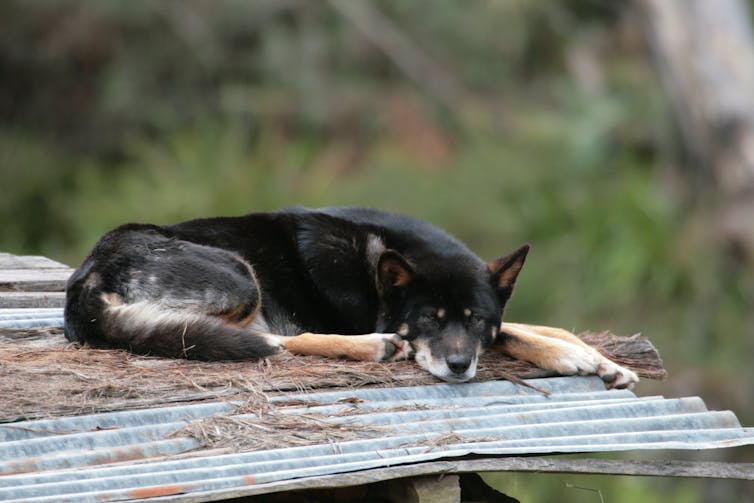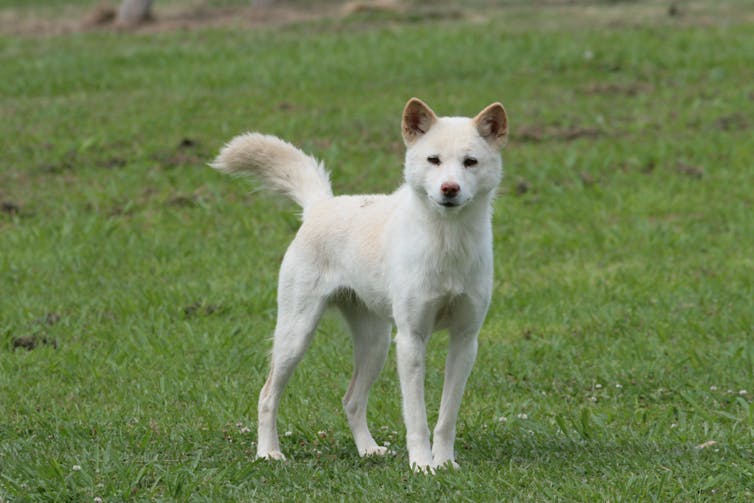MYTHS ABOUT THE AUSTRALIAN DINGO
If you live in Australia, you probably know very little about our native dog, the Dingo. If you live elsewhere you probably know even less! Here, some myths and misconceptions are revealed by Eloïse Déaux…
Dingoes do bark: why most dingo facts you think you know are wrong
As I visited a wildlife park in New South Wales in 2011, the keeper at the daily “dingo talk” confidently told us that “pure dingoes don’t bark”. After five years studying dingoes’ vocal behaviours, I can tell you that this is a myth. Dingoes do bark!
While travelling around Australia to study dingoes, I have had the opportunity to meet and talk with all sorts of people. One thing I realised is that the “dingoes don’t bark” belief is widespread – and it isn’t the only unproven dingo myth out there.
Lots of people in Australia take these three myths as hard facts:
- “pure” dingoes don’t bark
- “pure” dingoes are all ginger
- dingoes are “just dogs”.
But none of these are actually true and here’s why.
Myth 1: dingoes don’t bark
Anyone who has been around dingoes for long enough will tell you that they do bark, but not like domestic dogs. Dingoes’ barks are generally harsher, and given in short bursts.
Domestic dogs will bark anytime, anywhere, for anything (often to their owners’ or neighbours’ chagrin). This is not the case with dingoes. They will generally bark only when alarmed – such as when researchers trap them to fit a radio tracking collar, or if you stumble across one in the bush.
Dingoes can also bark if they get very excited (about food, for example) but this is quite uncommon. The rarity of these events probably explains the prevalence of the “no barking” myth – wild dingo barking just doesn’t happen often enough for most people to witness it.
Another associated misconception is that captive dingoes will learn to bark from listening to domestic dogs. Although humans are very good at learning new sounds – indeed, that’s how we acquire our language – most other species (including canines) can make only a limited range of vocal sounds, and can’t learn new ones.
So the fact that captive dingoes bark actually confirms that they have barking abilities right from the start. It is, however, possible that by listening to nearby domestic dogs, captive dingoes learn to bark more often and in more situations than they otherwise might.
It is easy to see how this myth might harm efforts to protect dingoes. Imagine a well-meaning pastoralist shooting or baiting anything that barks, in the mistaken belief that it’s not a dingo.
Myth 2: all pure dingoes are ginger
The “typical” dingo that people picture in their minds – think Fraser Island – will be ginger (or tan) with white feet and a white-tipped tail. But dingoes, like people, come in a variety of shapes and colours.
Importantly, although ginger dingoes make up about three-quarters of the population, there is genetic evidence that their coats can also be black, black and tan, black and white, or plain white.


There is also a lot of variation in the size and shape of white patches and these may even be absent altogether. It’s often thought that dingoes that lack ginger fur or white patches are dingo-dog hybrids, but this is not necessarily true.
Like the no-barking myth, misconceptions about coat colour can potentially harm dingo conservation. If we were to protect only ginger dingoes, we would unwittingly reduce the natural genetic variation of the population, making it more vulnerable to extinction.
Myth 3: dingoes are just dogs
This is perhaps the hardest belief to address, because it can vary depending on whether we look at their behaviours, ecology or origins. But this concept is arguably even more relevant to their conservation and management.
So is a dingo a dog? Although dogs’ evolutionary origins are still unclear, we know that dingoes are descendants of animals domesticated long ago somewhere in Asia and then brought to Australia. Dingoes are thus an ancient dog breed and so, yes, dingoes are dogs.
However, we also know that dingoes arrived in mainland Australia roughly 5,000 years ago and have since been isolated from all other canines right up until European settlement. Some experts argue that this makes them distinct enough to warrant protection from hybridisation with domestic dogs.
As dingo researcher Ben Allen puts it, “pure ones need to be distinguished from hybrid ones somehow, and it is the pure ones that have conservation value as a species”.
But as fellow dingo expert Guy Ballard points out, dingoes are undeniably a type of dog, so arguably all that really matters is that their function as top predators in the ecosystem is preserved.
But there’s a catch (as Ballard has acknowledged): we do not know whether dingoes, feral dogs and hybrids behave similarly – or in other words, whether all three can perform the same ecological role.
We do know that India’s free-ranging dogs behave very differently from Australian dingoes: they are inefficient predators, do not form packs and do not breed cooperatively. This suggests that, in terms of their behaviours, dingoes may be very different from other types of dogs after all.
Until we know more, the best approach to safeguarding dingoes and their role in the ecosystems might be to view and treat them as completely separate and distinct from other free-ranging dogs in Australia.
Far from being “just dogs”, dingoes really are unique dogs.
About the author:
Eloïse Déaux, Postdoctoral fellow in mammal vocal communication, Université de Neuchâtel
This article is republished from The Conversation under a Creative Commons license. Read the original article.






